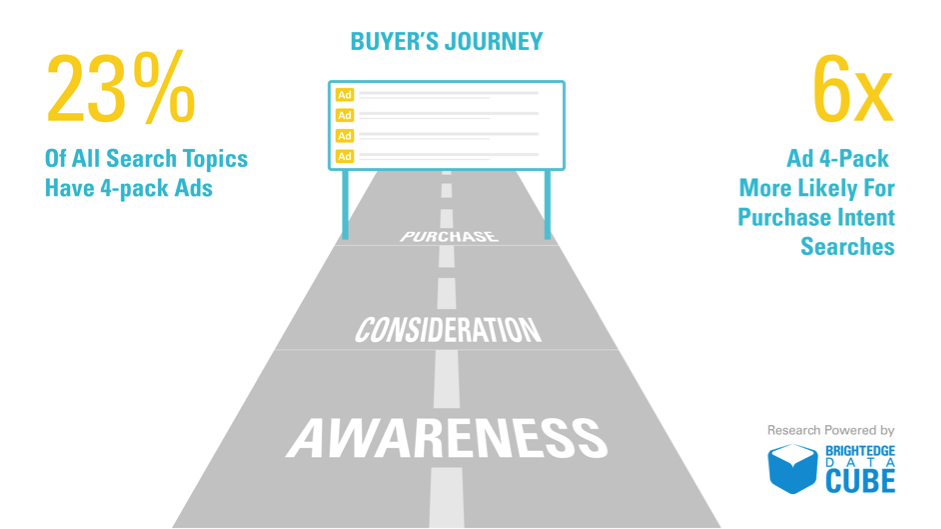Brand new research out today reveals that, since Google AdWords removed its right-hand side ads and brought in an occasional fourth paid ad position for ‘highly commercial’ search terms, this fourth ad appears for nearly one-quarter of all search topics.
It’s been an interesting time for search marketers, with lot of early research indicating various different trends and anomalies for the new look SERP.
The major worry is that paid search advertising will become more competitive and that organic results are getting pushed further and further down the page.
Although one of the surprising developments is that having your ad appear in position 4 may lead to as high CTR as position 1.
Today’s research however highlights the need for paid search teams to align their strategies with customer intent.
As well as the headline stat, BrightEdge has discovered the following important takeaways you need to be aware of:
- Searches indicating purchase intent are six times more likely than all other searches to display this four-pack of ads.
- Searches with discovery intent have a 69% higher click-through-rate (CTR) for the top five search results, as compared to purchase-intent searches.

What does this all mean?
That customer intent is everything, and that the ‘micro-moments’ that you will have heard Google recommending you pay attention to, should be right at the top of your search strategy.
What are micro-moments?
As Chris Lake mentions in his post on how to optimise for near me search, Google says micro-moments are the “critical touch points within today’s consumer journey, and when added together, they ultimately determine how that journey ends.”
Or to put it simply, the
- I-want-to-know moments
- I-want-to-go moments
- I-want-to-buy moments
- I-want-to-do moments
These all have three things in common – immediacy, context and intent.
So going back to the BrightEdge research, Google is creating a pay-to-play battleground where the only winners will be the marketers who align their paid search efforts with customer intent.
According to Google, examples of commercial queries include topics such as “hotels in New York City” and “car insurance”. Other examples are “CRM software” and “energy management systems”. Also note that research from Sirius Decisions indicates that 67% of the B2B buyer’s journey is now done online.
That’s not to say there’s no room for organic search marketing for commercial terms…
How organic and paid search marketers can work together
The key to search marketing is supporting organic efforts with paid advertising, and filling the gaps when on-page SEO and content marketing isn’t enough.
However you must understand that with Google becoming ever savvier about quality, it’s vital you’re creating content that’s trustworthy and relevant.
But as the research points out, “searches with commercial intent on average display a higher number of ads at the top of the page than other searches, click-through-rates are lower for organic search results as compared to those with fewer top-of-the-page ads.”
So again, it’s now much harder for organic results to gain any love on SERPs for commercial search terms.
The key is knowing which commercial terms have organic search results above the fold, so organic and paid search teams can work together in targeting these terms to boost ROI for both paid and organic efforts.
You should also research which pages are currently ranking for these terms and create further webpages that help bolster this presence, by mapping content to exactly what searchers are looking for.
And then for search topics where there are fewer ads displayed, organic search teams should take the lead in creating content that delivers on all points, from relevancy, to quality to user experience, in order to attract and retain customers.
For more on the research, check the full report from BrightEdge.
No comments:
Post a Comment